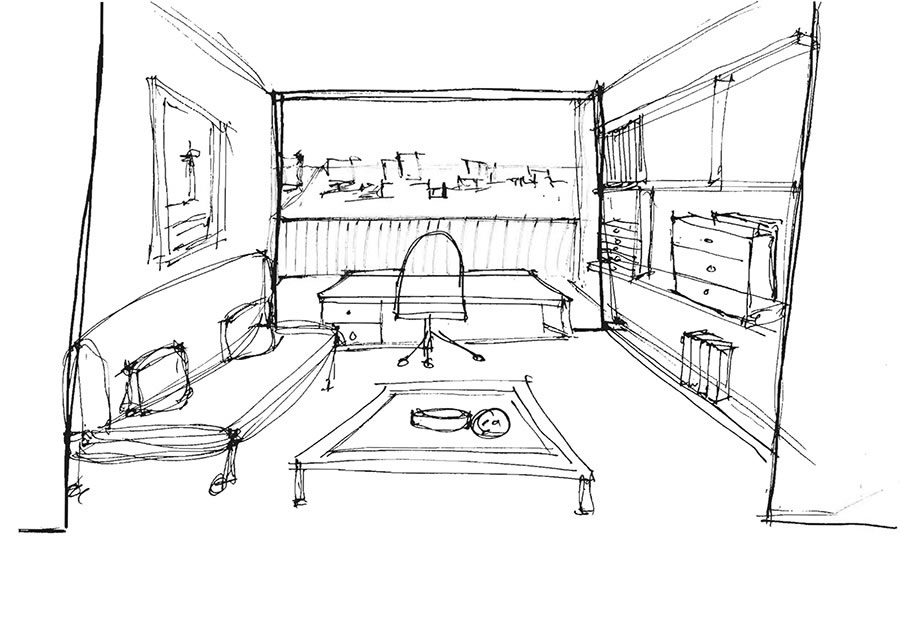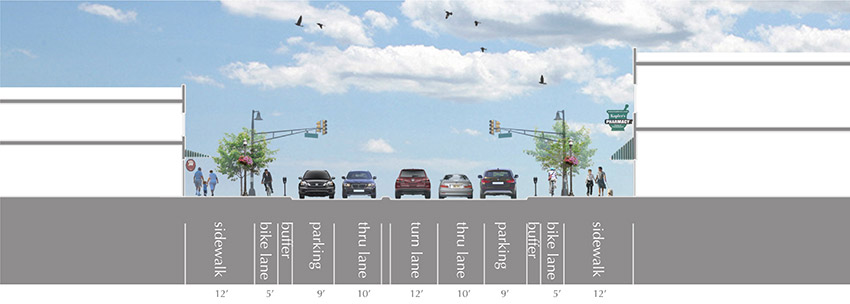

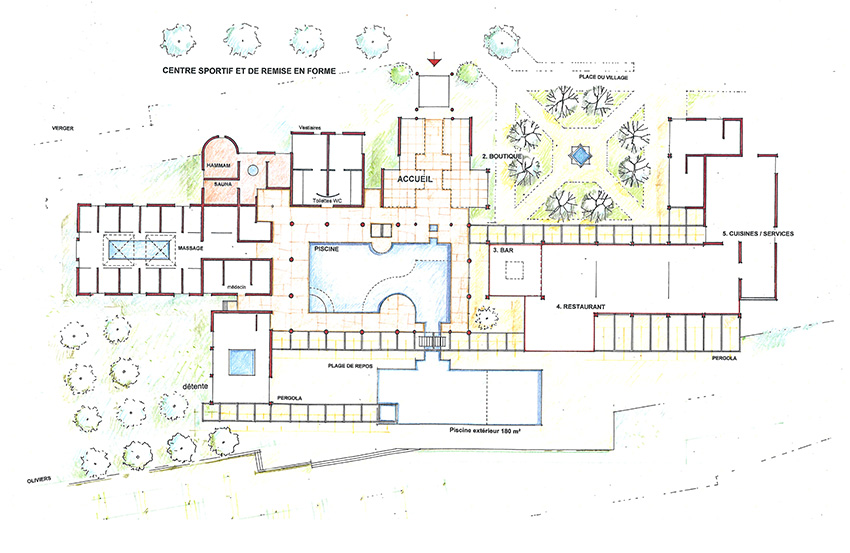
OXYGENE Isle-sur-la-Sorgue, FR
Scope: 110 Million Euro vino-aroma therapy and sports spa project in the South of France
Details: Vineyard setting near L’isle sur la Sorgue in Provence. 80 apartments/5 “Mas” of 6 rooms each, Bar, restaurant, conference facility, sports center with three exercise rooms and one cardio/weights room, holistic beauty center, treatment center, administration offices, medical center, cooking stage, organic garden.
Style: Provencal Traditional Village
Description: Oxygene was a project born of Caroline’s experiences working in the spirits and wine business and getting fit at sports spas out west when she was on holiday in the States. The idea of a Vinotherapy spa grew from there. None existed at the time. Caudalie had created a line of products, but their spa had yet to open. Caroline created the concept, wrote the business plan, raised capital, found a location nestled in the vineyards of the Vaucluse where to build it, worked with an architectural firm to draw the plans and worked with business leaders, bankers, investors, and the regional tourism authorities developing the project. “Vinotherapie” describes a beauty therapy process where the residue of wine making (the pips and pulp) are rubbed into the skin. The pulp is said to have excellent exfoliating qualities and help reduce the problems associated with ageing. Treatments accompanied by dermo-creams and oils containing the extraction of Grape Seed Polyphenols (OPC) are used to increase circulation, skin elasticity and promote an overall healthier cardiovascular system.
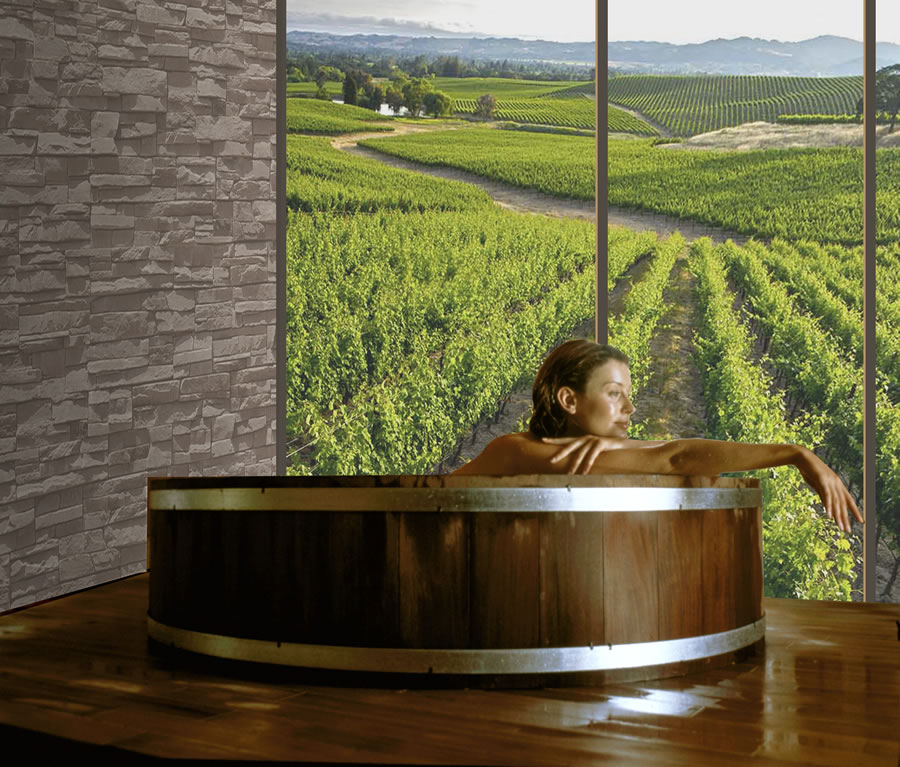
Micro Vines
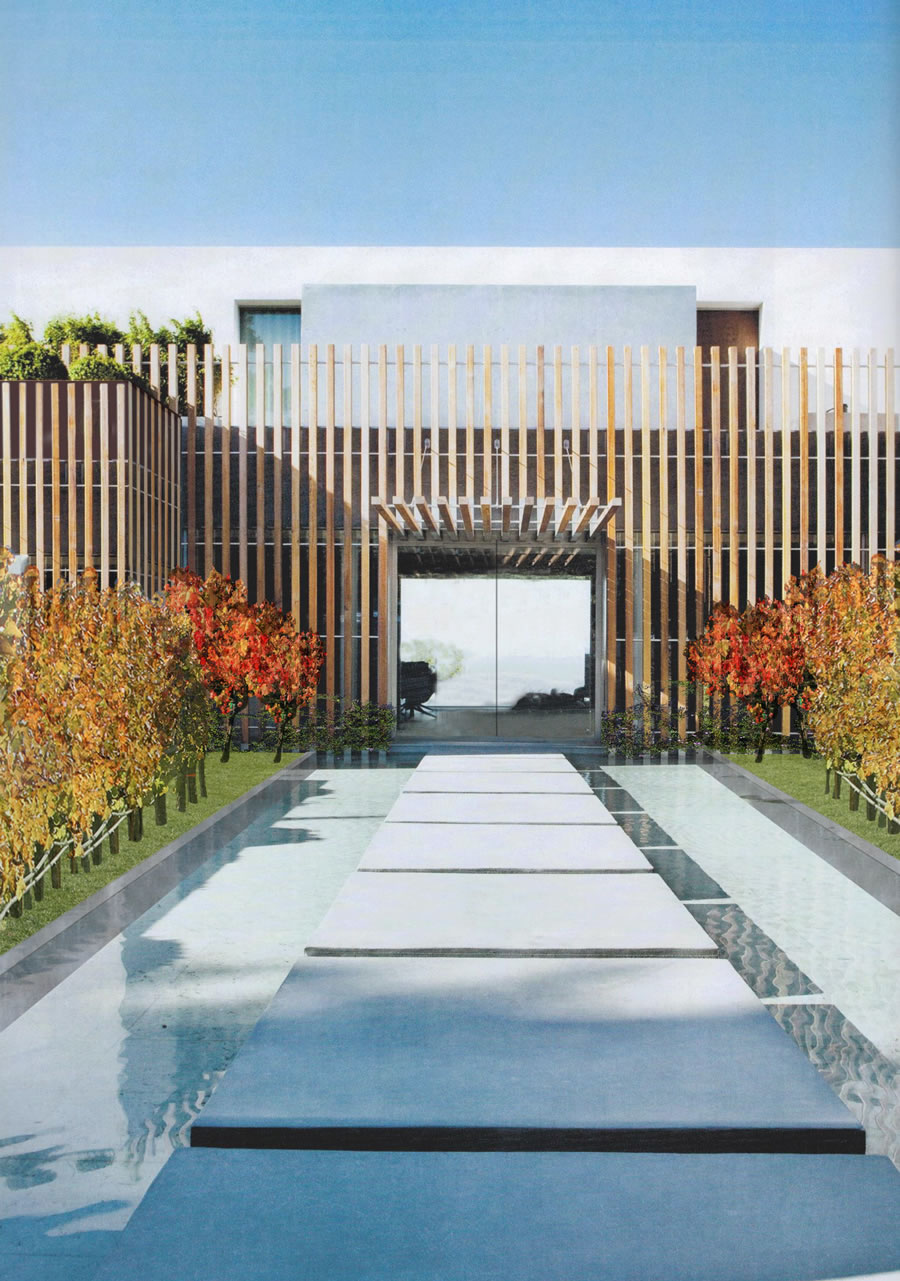
Arcadia Vines
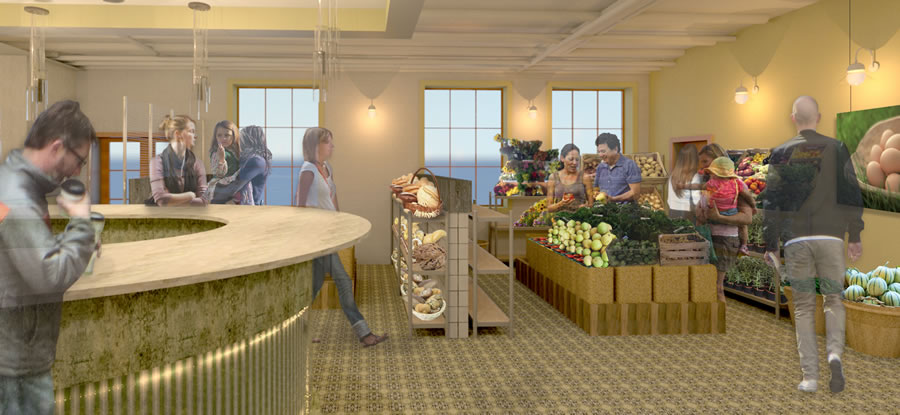
Mini Halles

Arcadia Halles
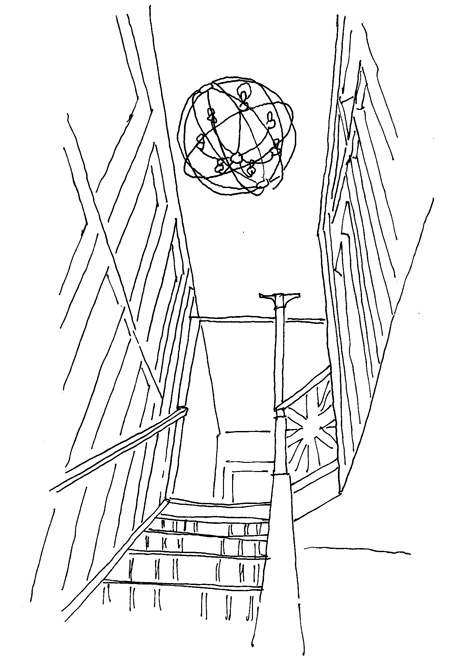
Ultimate Beach House
Scope: Design, Renovation, Build, Contracting, Antique-sourcing, Cabinetry/Furniture Creation, Painted Finishes, Decorating
Details: Space transformation and opening to exterior. Complete transformation of exterior and interior. Addition of 35% overall living space. Materials were reclaimed and simulated reclaimed. Nautical Wall TV Cabinets created. Extensive OUTinDesign bespoke millwork and cabinetry.
Style: Transitional French and American Mid-Atlantic Coastal
Stats: Front addition of gabled entry on first floor and bedroom on second. Back addition of indoor porch dining, sleeping porch Master South and outdoor-indoor yacht club stairwell. Reclaimed barn wood oak floors, all wood-plank-clad walls down stairs, bead board and wood accents downstairs and upstairs, extensive OUTinDesign bespoke cabinetry and millwork: nautical stairwell, lighthouse loft, sailboat storage bed, barn laundry, boathouse closet, kitchen/dining open china wood and hemp wall unit.
Description: The Ultimate Beach House demonstrates OUTinDesign’s design ethos, meshing the indoors and the outdoors. Its design marries our French and American coastal roots while being firmly rooted to its locality. Exemplifying the historic Beach Haven architectural vernacular, the Victorian exterior belies the modern design of the interior spaces which so effectively engage the outdoors. At the heart of the ground floor, the centrally-located kitchen creates an interactive arena in which to celebrate with good food and wine. The back of the house consists entirely of glass doors and windows that connect seamlessly to the garden. An outdoor “room” is created by architecturally-designed flower beds, permeable oyster shell and slate patios and “compartment” spaces for dining, relaxing and celebrating.
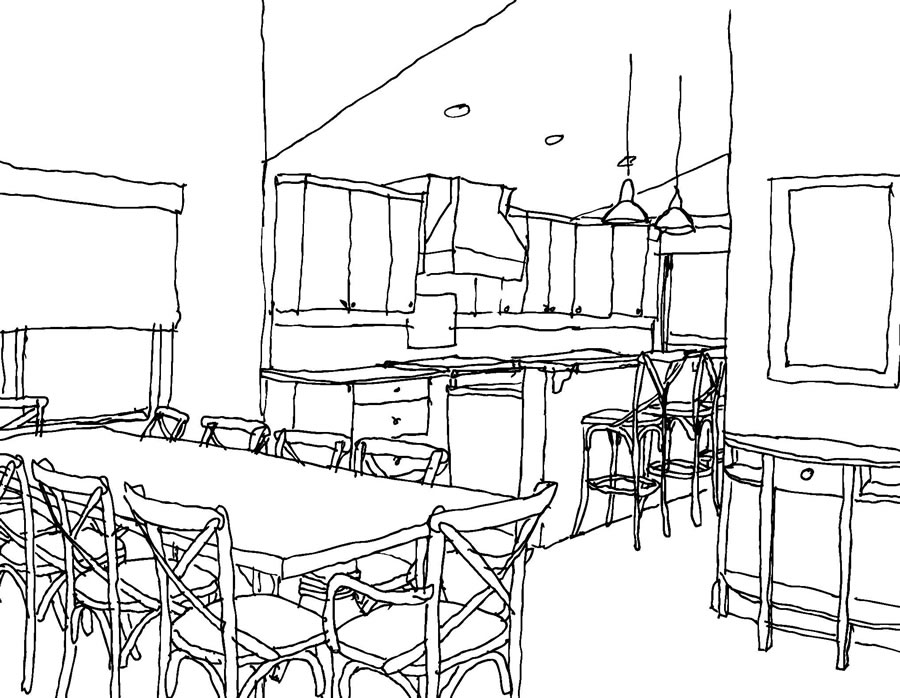
Beach and Bay House
Scope: Design, Bath/Kitchen/Lighting/Furniture Concepts and Implementation, Millwork and Cabinetry, Furniture Sourcing, Cabinetry/Furniture Creation, Decorating
Details: Design using reclaimed and artist-finished materials. Bespoke OUTinDesign Wall TV Cabinets created. Two bedroom TV vanity cabinets created, custom fireplace and hearth in sea rock.
Style: Belize meets Cape Cod, Classic Contemporary Reverse Living
Description: Rising on a swath of land where the island had all but washed away, the eponymously named Beach & Bay House commands sweeping views of both. Inside, its sophisticated demeanor steals nothing from its true-to-the-core beach soul. The owners wanted a typical beach cottage ensconced in its Long Beach Island roots that was at once sophisticated and charming. The wife had her aesthetic preferences, while the husband wanted to fulfill his dreams of building a coastal gathering place where his just-left-the-nest children would want to spend time with the family relaxing, enjoying the beach that they all loved equally. While the prerogatives were different, both wanted a comfortable, beachy beautiful home in which to celebrate and invest in memories long-term.
The reverse-living house is raised and organized with two living spaces on the first and second floors. One enters the house up a stairwell to arrive in the out-in family room that is commanded on one side by a full-wall, hidden bar-TV closed off by wrought iron gates lending a secret garden feel to the room as if one is outdoors and the gates lead somewhere forbidden. Sea grass furniture and woven rugs and blinds lend an island feel. Themed bedrooms fan off from the hallway at the end of which is the daughter’s “junior master” in which light aqua hues and diaphanous fabric literally make one feel island breezes. The daughter’s chest of drawers is topped by a mirrored reclaimed window cabinet that hides a flat screen TV. Moroccan tile the color of an exotic pool lines her shower, while the original light fixtures wink at the nuanced colors found in the contrasting wall tile. A Cape Cod bathroom down the hall has compass knobs and rustic rope fixtures.
Upstairs, the floors are a dark gray with white graining – driftwood reclaimed oak. They contrast beautifully with the gleaming white bead-board-clad cathedral ceilings. The sea glass kitchen has recycled translucent glass counters, sharp white cabinets and matching sea-glass knobs. Color-coordinated glass subway tile line the kitchen perimeter and the kitchen island that is over lit with 19th century white factory lights and under lit for effect. Adjoining the kitchen, a deck to the south, a white and aqua living room to the southwest and a dining room to the west, are all furnished in reclaimed wood furniture with white linen upholstery. In the corner, the focal point of the room is the beach stone and stucco fireplace with reclaimed mantle and slate hearth. The master bedroom and bath are designed to accommodate the more sophisticated taste of the lady of the house and have white-washed oak 18th century French furniture and spectacular light-capturing tile and original lighting in the master bath.
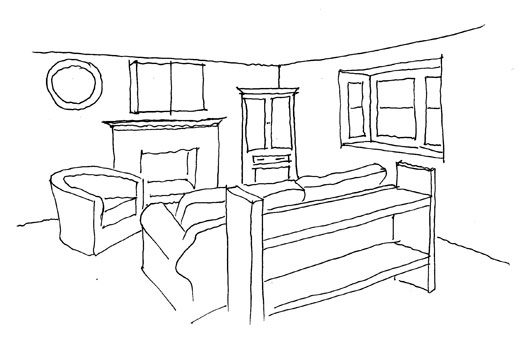
Atlantic Cape Cottage
Scope: Design, Renovation, Contracting, Antique-sourcing, Cabinetry/Furniture Creation, Decorating
Details: Space transformation. Some walls were removed to create holistic living spaces. Major remodeling using reclaimed and artist-finished materials. First OUTinDesign Wall TV Cabinets created.
Style: Cape Cod Fisherman’s Cottage/Brittany Coast Boathouse
Description: The cottage is steps from Beach Haven’s Little Egg Harbor Yacht Club and has a nautical feel. White cloaks the plank walls, pickled floors, and furniture. The house transitions from the outdoors to the indoors seamlessly. Furnished with a combination of vintage and antique furniture sourced from Maine and France, it boasts sea-originating pieces like a lobster pot coffee table and a driftwood mirror. The linear open-plan living area connects a family room, a dining nook, and a sunroom that open to a vast flower-filled garden. Porthole lights along the stairwell, fabrics from Belgium and local-beach-sand-hued concrete countertops add to the originality of the house’s sophisticated charm.
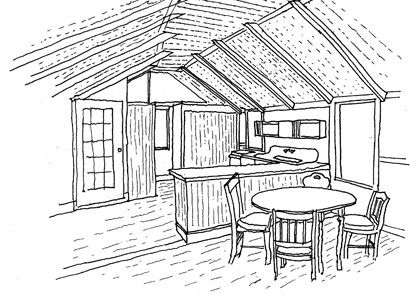
Maine Port Cottage
Scope: Design, Restoration, Renovation, Contracting, Antique-sourcing, Cabinetry/Furniture Creation, TV Armoire Creation, Painted Finishes, Decorating
Details: Space transformation. Walls removed between living, dining and kitchen. Re-build/major gut-renovation using green and reclaimed materials.
Style: Victorian Cottage
Description: This historic cottage was crumbling and in danger of being condemned and torn down. OUTinDesign planned a major restoration and renovation that included adding significant space (+400 SF of living space) via the addition of two 12-foot dormers on either side of the newly replaced roof and a reconfigured attic, hallway, closet and pantry. We created a barn kitchen (early 19c. planks were transferred board by board from the main attic of the original part of the house to the 1930’s addition. There we constructed a barn-ceiling in the created open-plan kitchen-dining area to which we added glass doors to access a large deck we’d added that overlooked a tripping stream and majestic pines. We rebuilt the original front porch, using it to inspire the style of the back deck and converted a window overlooking the woods to double French doors to access it, then custom built wood cabinets, sourced antique nautical hardware for knobs, and sourced antiques and vintage furniture that we re-finished with a small army of local artists. We removed three walls and four ceilings; reconfigured the main upstairs hallway, master bedroom and closet and re-designed the upstairs to accommodate the addition of a second bathroom and a third bedroom. We finished the walls and ceilings with stained bead board, reclaimed wood or whitewashed pine plank and converted a brick chimney into a bookcase in the newly created open-plan living room born of the former parlor and library. We restored the wide-plank heart-pine and oak flooring throughout and exposed original beams in all the rooms.
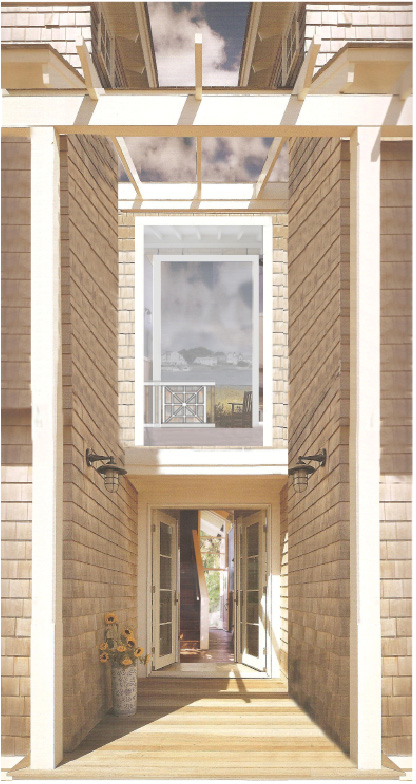
Lagoon Porch House
Objective: Create a beach house that epitomizes the distinguishing feature of early 20th century mid-Atlantic Coast cedar shake cottages, the wraparound porch. The Lagoon Porch House takes the porch and draws it both into the house and extends it outward so it literally reaches out to greet one on the exterior all the way around the house. The design intends to exploit the essence of one’s best memory of summer, a place in time where all was easy and good. Lolling on a porch is the summation of relaxation for vacationers and seeing a house with a porch often immediately expels stress and brings one back to the best of times. The Lagoon Porch House’s design seeks to deliver this emotive reaction.
Scope: The Lagoon Porch House is two houses in one connected by an atrium “arbor”. The design turns reverse living on its head – or more precisely – on its side. One water-view house is intended for living and one street-view house is intended for resting. With two modules, all the playing and eating and celebrating takes place in the living module or house while all the sleeping, primping, bathing, and alone time takes place in the resting module.
Style: The design of the Lagoon Porch House is Nautical Transitional. Mindful of coastal architectural heritage it draws on the best of beach design on the exterior while incorporating elements of design that answer to today’s needs and wants. The design is composed of two four squares joined by an atrium, with a wrap-around porch encircling the entire house on both floors. The number of windows has been exploded and the porch has been drawn inside to magnify the effect of living outdoors while on holiday. The style, however, is steeped in tradition. Extrapolated from American Four Square, its style was popular from the mid-1890s to the late 1930s. Following the increasingly ornate decorative elaboration of the Victorian homes though the late 19th century, an architectural pendulum swing rendered a return to plain design. Elements of the four square incorporated a heavy use of woodwork (unless purchased from a mail-order catalog) and elements of the Prairie School and the Craftsman styles.
Detail: The house is dressed in red cedar shakes with a standing seam steel roof of sea foam green. All trim is white. Dormer windows are situated on two sides of each of the houses to flood the spaces with light. Traditional white wood post style porches wrap the structure with intermittent nautical detailing. All decks are wood. The landscaping is all sand, weathered wood decks, dune walkways and shell. The interior is ascetic, curated with whites of many textures and woods finished in a variety of tones.
Description: The design affords assured peace and quiet in the house reserved for rest, while the living space is always abuzz with activity. In the Rest House are five sleeping areas: a master and guestroom on the top floor and a sleeping porch, a bunked sleeping cubby, and a junior master on the first level. In theLiving House, an indoor “porch” serves as the great room and has a river stone-clad fireplace and hidden bar as its focal point. .Views overlook the lagoon and bay. A massive cathedral ceiling allows for a small lofted library-cum-office abutting the atrium. Below, the kitchen and dining room meet at the “barbecue pit” in the middle of the open space allowing for year around outdoordining indoors. Nana Walls marry the indoor to the outdoors seamlessly with disappearing glass doors both upstairs and downstairs. One is thus connected to the deck and switchback porch stairs that lead to the beach garden. Indigenous beach grasses and conifers grow wild amidst a series of dune walkways that define the space. An infinity pool that empties into the lagoon is punctuated by octagonal decks where arbors made from unstripped branches provide shade for weary beachcombers sipping cool cocktails after a seaside day.
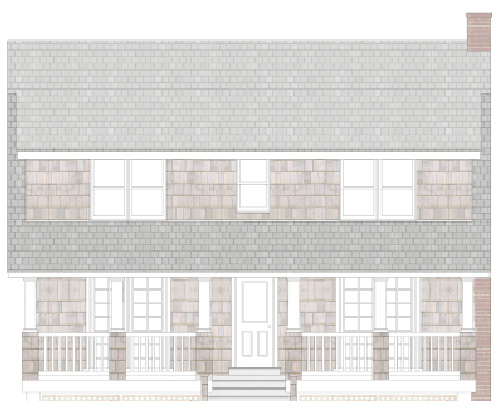
Coastal Beach Cottage
Scope: Design, Restoration, Remodel.
Details: Space transformation. Walls removed. All systems replaced/updated. Re-build/major gut-renovation
Style: Cedar-shake Dutch-Colonial, 1912
Description: This Dutch Colonial cottage sat proudly on the beach block in the venerable Yacht Club District of Beach Haven. Generations of the same family had bickered over the smallest change so little had been done to the turn-of-the-century house and a major remodel and update was needed. The new owners asked OUTinDesign to undertake remodeling and reconfiguring the house, designing the landscaping and creating a space for visiting guests. The objective was to accommodate the changing needs of their family that included two children in college and another who was getting married. The couple knew they’d need more space and optimized space along with the extensive renovation. A two-phase project was planned in which phase one called for a complete overhaul of all systems, creation of an apartment, the addition of two bathrooms, one, a master bath creation off the current master bedroom with a phase two addition off the back of the house in which a large master suite with en suite bathroom and sitting room would be added upstairs and a pantry/laundry/office nook would be added off the reconfigured and completely remodeled kitchen downstairs. The attic would be transformed into a spare bedroom. Since the house was located in the historic district and the changes were extensive, permitting required going through the Historic Review Board of Beach Haven and applying for a variance.
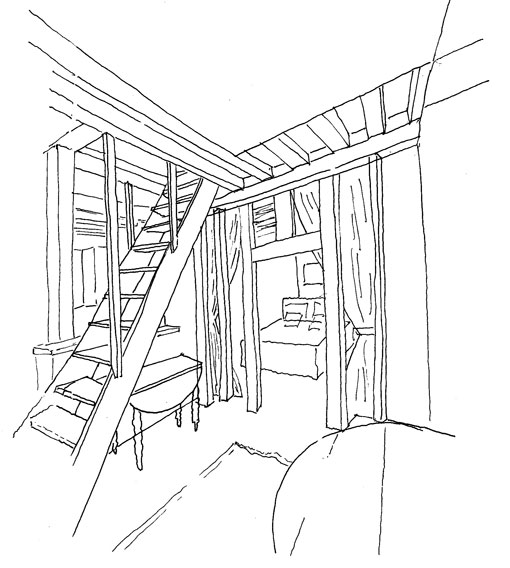
Latin Quarter Apartment
Scope: Design, Renderings, Plans, Historical Review Board Submittal, Restoration, Remodel, Renovation.
Details: Gutting, removal of walls, kitchen remodel, bathroom remodel, addition/combination of space. Wall, ceiling floor treatment and finishing. Faux-finishes, antique sourcing, rug purchasing.
Style: French Classic/North African: The style of the apartment is 17th century-rooted with details demonstrating the owners Brittany-roots and passion for the eclectic.
Description: The apartment in the 17th century building in the Latin Quarter of Paris previously consisted of three tiny apartments: three one-bedroom apartments, two on the second floor and the other one on the third floor. After conversion, one of the two rooms on the third floor was a “study”, but actually it was nothing more than a big landing. Below, the living room was deep in the dark recesses of the apartment next to the bathroom. It was decided to move the entrance and living area upstairs where the light was abundant and, with some imagination, the possibilities were vast. A wall between the study and bedroom was demolished. Wooden beams were mounted on either side of the room to support the newly exposed ceiling. These beams were beaten, chopped and aged to look like the 17th century ones overhead. The wood floors were limed, giving them a buffed, transparent white finish that accentuated the light that flowed between the t s and shades of white’s married with textures like linen, chenille, jute, and burlap. Lime-plastered walls were adorned in places with delicate leaves stuck directly into the moist plaster, a contrast to the mostly rough materials that give the room its earthy feel.
Downstairs, set against the 17 century beams, the kitchen’s linear quality is enhanced by stark sea green tile, contemporary honey cabinets and stainless appliances. Walls are painted in an old world patina – a taupe base over which a Greek blue was applied. The wax finish to the wall renders a weathered look.
The non-descript stairs called for creative surgery. To make them match the many 17th century beams in the apartment, they were sanded, and then chains, hammers, axes and drills attacked them. Finally, after staining, the stairs look like they belonged there. An old Aubusson tapestry was hung above a Louis Philippe console that was found in a remote antique shop’s garden in La Perche, a rainy area abutting Normandy.
Beyond an opened “wall” of old beams lies the bedroom. A custom-upholstered bed sits between a window that opens to the inner covered courtyard of the building on one side and an armoire, painted with huge green leaves on the other. Green and white toile de jouy fabric drapes and pillows add a splash of color. Lime-plastered cream walls contrast the stark white of the bed. Behind the bedroom, a magical trip to Brittany awaits. Slate and Brittany stone cover the walls and floor of the Douche Italienne open shower, with it sloped floor and glass panel “wall”. A large open vasque in Bretagne granite serves as the sink. Wall faucets are inset in the multi-color mini glass subway tile backsplash. Done in a driftwood décor, everything from the flooring, to the WC, to the coffered tub to the cabinets and shelves is driftwood (faux driftwood). The lighting emits from portholes.
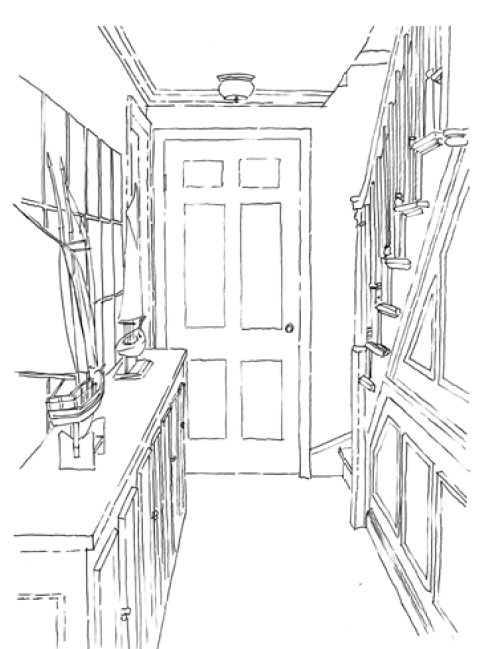
Old Town Townhouse
Scope: Design, Sketches, Contracting, Restoration, Remodel, Renovation, Landscaping.
Details: Kitchen update and replacement of all surfaces and appliances, Walls and Floors: New finishes, Bathroom updates, Systems updates, update and renovations to bedrooms.
Style: French/ Traditional
It was time to remodel the Old Town Alexandria Town House. Williamsburg Blue dominated throughout and the style was heavily 1980’s chintz. In its place, favorite colors and a more subdued, sophisticated style that reflected the new owner’s personality replaced the cheerful, but outdated look. Inside the foyer, a 19c. Empire-style armoire was set off beautifully against the luminous, trompe-hued taupe that she juxtaposed against original rich latte-cream molding. the new owner painted the library persimmon red to contrast with the rich cream crown molding and bookcases that cover the walls. A collection of French classics dating from the 18th century through the existentialists spans an entire side of the room. A family heirloom silver platter sitting on a cast iron base serves as the coffee table. A 19 c. leather-embossed desk sits in the corner.
Down the hall, the living room serves double duty as a dining room for special occasions. It was drastically changed to suit her love for sage green. She painted the shadow boxes with a diamond motif green sage wash over the silver sage background. Over-sized armchairs are covered in a Cowtan and Toutlarge-print paisley blue sage damask and the Louis XV and Louis VI antique chairs and the table are covered in a Bruschwig et Fils silk and jute stripe fabric.
The kitchen had been remolded recently so it required only a bit of decorating to leverage the décor of the previous owner who had put in aPierre Deux tile back splash and terracotta tiles. French ceramics hang from the walls and adorn the shelves. A French iron café table and chair set were painted in Provencal blue with a vine motif to match the tiles. Topiary animals of Provence hang from the ceiling alongside bunches of dried lavender.
The former dining room is painted in an ochre lime wash with white and red trim. This family room is where the owners eat at a drop-leaf table. An antique French country armoire dominates the room. It is filled with linens made by Belgian nuns at the beginning of the 20th century. Two sets of French doors flanked by Provencal yellow paisley stripe damask drapes open to the lush landscaped patio where they eat most meals, spring to fall. The rest of the year, they spend their down-time relaxing on a sofa and armchair with slipcovers made fromSchumacher Arrangiamento Di FioriItalian striped poppy, olive and champagne damask. 1930’s side tables that double as bookcases were given a new face by the owner with Fleur de Lis motifs. They sit at either side of the sofa. TV and stereo are hidden in cabinets on either side of the fireplace mantle.
The Master bedroom was transformed from blue, yellow and white floral to taupe, beige and linen. A wedding present of taupe locust fabric from the market at Isle-sur-la-Sorgue was made into a bed throw. Around it is a room of restful colors and complementary fabrics. The walls were dragged with a taupe glaze over a base of linen. Closets and trim are painted in mat beige. Overhead, linen catches the light and complements the custom shades. The striations of color on the walls reflect the sun that flows through the south and west-facing windows. The curtains and headboard are Stroheim & Romanbeige and cream toile fabric with a country squire motif. Around the room is a collection of the owner’s grandmother’s Italian painted canvases from the “boiseries” of her Rue de Passy home. They were part of a collection of 16 18th century “toiles” in gilded moldings surrounding shadow boxes throughout entire first floor of the Parisian duplex apartment in the 1930’s. In Alexandria, the five surviving ones have been framed in molding-like frames and hung around the room to simulate French “boiseries decoratives”. An Empirechest and two Louis VX Bergèresupholstered in their original tapestry blue sage sit on either side of a delicate 19 c. vanity. A local artisan in Vaison-la-Romaine made two flower-pressed arc shades for converted gas lamps. They match the motif in the five paintings of theboiseries. A Marqueterieantique card table serves bedside.
Translucent green Opaline lamps on either side of the bed lend a touch of color contrast to the soft beige and taupe palette.
The top floor, home to the two daughters of the former owners, both grown, has been restyled to accommodate the younger daughters of the current owners. Leveraging the light that predominates on the fourth floor, white damask and a mix of Souleiado’s Collection Petits Bleusfabrics was used to upholster the daybed, curtain and cushions of the sofa. The room serves as a sitting room as well as a bedroom. The second bedroom is decorated in feminine blue, pink and white. On the third floor, the guest room doubles as the owner’s office.
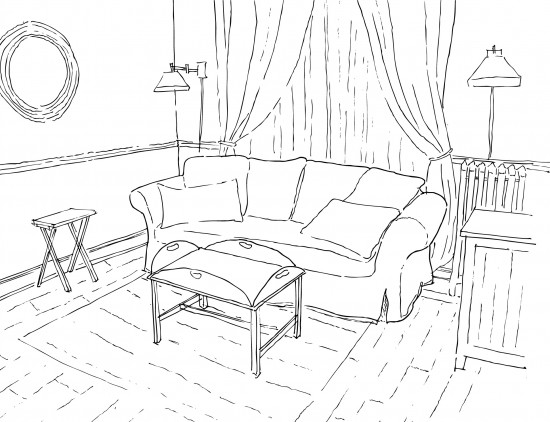
New York City Flat
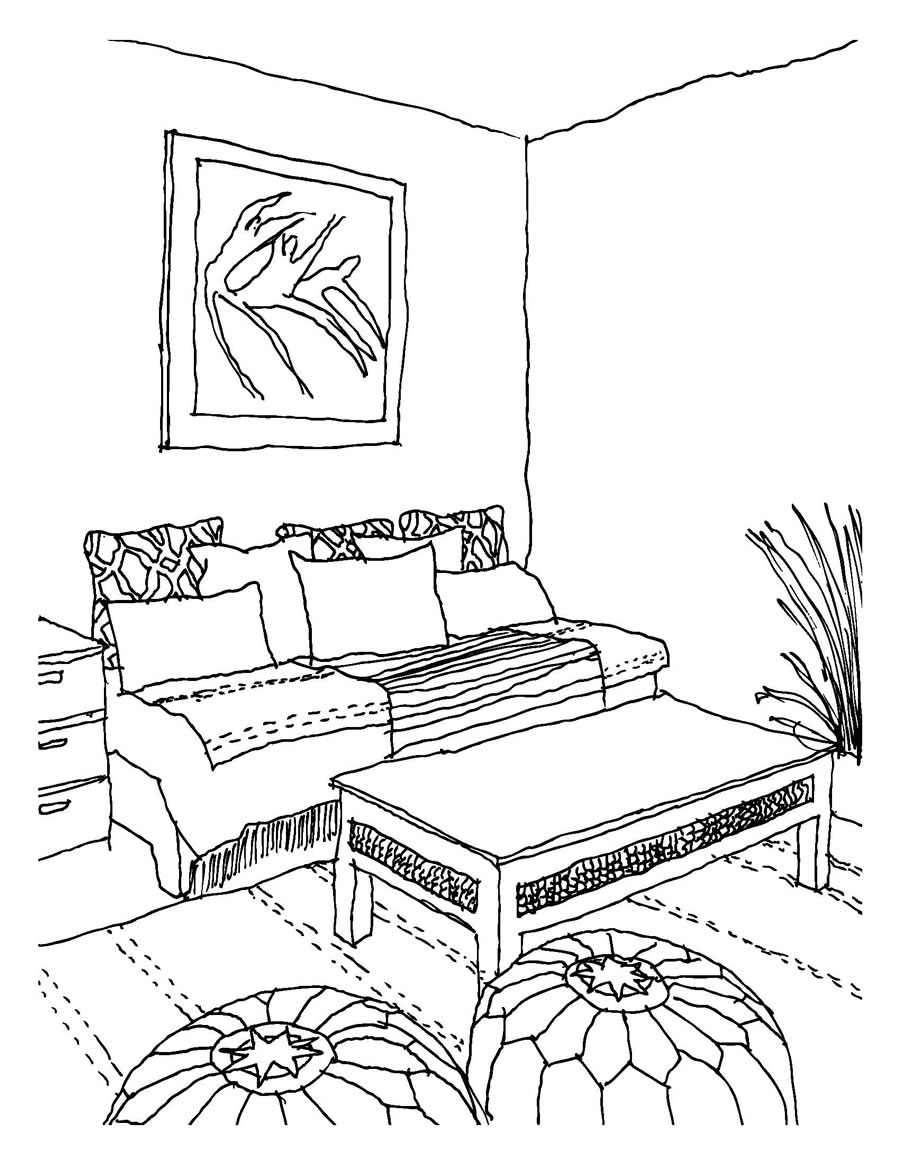
Modern Eclectic
